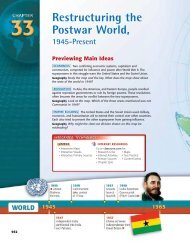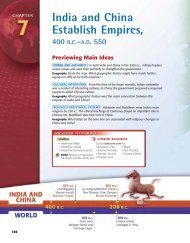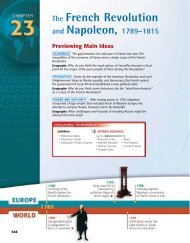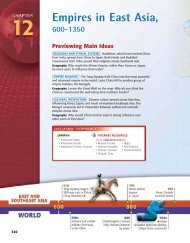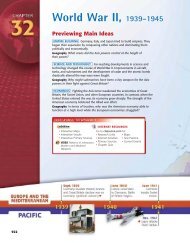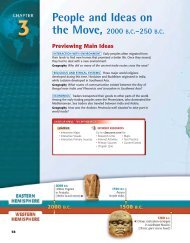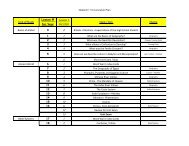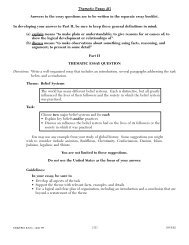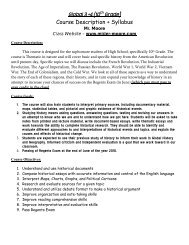Chapter 34 - First
Chapter 34 - First
Chapter 34 - First
You also want an ePaper? Increase the reach of your titles
YUMPU automatically turns print PDFs into web optimized ePapers that Google loves.
SECTION 5 ASSESSMENT<br />
TERMS & NAMES 1. For each term or name, write a sentence explaining its significance.<br />
• Transcaucasian Republics • Central Asian Republics • mujahideen • Taliban<br />
USING YOUR NOTES<br />
2. Which challenge for the<br />
Central Asian nations is most<br />
difficult to overcome?<br />
Freedom Brings<br />
New Challenges<br />
A.<br />
B.<br />
Afghanistan g and<br />
the World<br />
A.<br />
B.<br />
leaders accused the Taliban of allowing terrorist<br />
groups to train in Afghanistan. The Taliban<br />
also provided refuge for terrorist leaders,<br />
including Osama bin Laden, whose al-Qaeda<br />
organization is thought to be responsible for<br />
numerous attacks on the West—including the<br />
attacks on the World Trade Center in New York<br />
and the Pentagon in Washington, D.C., on<br />
September 11, 2001.<br />
In the wake of the September 11 attacks,<br />
the U.S. government demanded that the<br />
Taliban turn over bin Laden. After its leaders<br />
refused, the United States took military action.<br />
In October 2001, U.S. forces began bombing<br />
Taliban air defense, airfields, and command<br />
centers, as well as al-Qaeda training camps.<br />
On the ground, the United States provided<br />
assistance to anti-Taliban forces, such as the<br />
Northern Alliance. By December, the United<br />
States had driven the Taliban from power.<br />
Challenges Ahead While the Taliban regrouped in remote parts of Afghanistan and<br />
Pakistan, Afghan officials selected a new government under the leadership of Hamid<br />
Karzai. Later, in 2004, he was elected president for a five-year term. His government<br />
faced the task of rebuilding a country that had endured more than two decades of warfare.<br />
However, in 2006, the Taliban appeared resurgent, and NATO troops took over<br />
military operations in the South. Heavy fighting with the Taliban continued into 2007.<br />
The challenge before Afghanistan, is neither unique nor new. As you will read<br />
in the next chapter, over the past 50 years countries around the world have<br />
attempted to shed their old and often repressive forms of rule and implement a<br />
more democratic style of government.<br />
MAIN IDEA<br />
3. What countries make up the<br />
Transcaucasian Republics? the<br />
Central Asian Republics?<br />
4. Why did Afghanis oppose the<br />
notion of Communist rule?<br />
5. Why did the United States take<br />
military action against the<br />
Taliban?<br />
CONNECT TO TODAY CREATING A TIME LINE<br />
Choose one of the countries discussed in this section and create a time line of the eight to<br />
ten most significant events in its history over the last 50 years.<br />
▲ In the<br />
Afghanistan<br />
elections, the ballot<br />
included<br />
photographs of the<br />
candidates and<br />
symbols for each<br />
party.<br />
CRITICAL THINKING & WRITING<br />
6. MAKING INFERENCES Some historians call the Soviet-<br />
Afghan war the Soviet Union’s “Vietnam.” What do they<br />
mean by this reference? Do you agree with it?<br />
7. DRAWING CONCLUSIONS Why might Afghanis have been<br />
willing to accept Taliban rule by 1998?<br />
8. IDENTIFYING PROBLEMS Why did the new nations of<br />
Central Asia experience such economic difficulties?<br />
9. WRITING ACTIVITY POWER AND AUTHORITY Imagine you<br />
are a speechwriter for Hamid Karzai. Write what you feel<br />
would be an appropriate first paragraph for his initial<br />
speech upon taking power.<br />
The Colonies Become New Nations 1027





